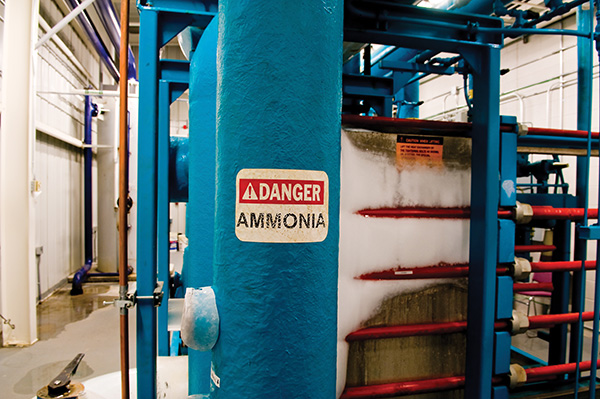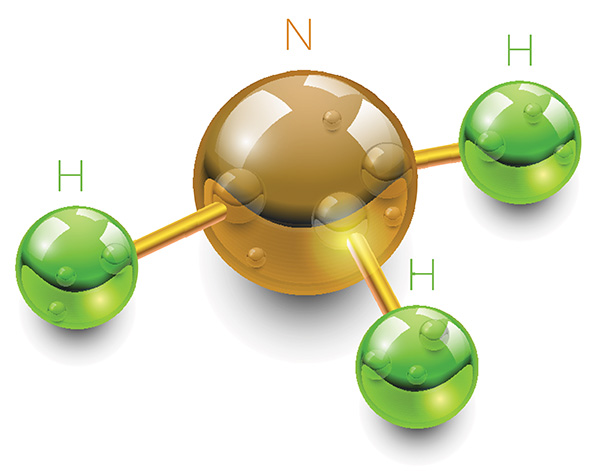
Ammonia … The Refrigerant
April 18, 2023 | By Dave Demma
When used in large volumes as a refrigerant, this naturally-occurring gas requires the utmost in safety.

(Getty Images)
For those who are not in some way associated with the refrigeration industry, a mention of the word ammonia will bring to mind a common household cleaner. It’s available in every supermarket, and is commonly used for cleaning. It smells a little, but it’s tolerable to be around … especially if it’s lemon scented.
The Parsons brand of ammonia cleaner contains the following warning on the bottle’s label: “Harmful if swallowed”. It also labels the product as an “Irritant”.
That is the perfect description. It is somewhat irritating to be around, but it is not what one would consider to be a dangerous product. If you happen to spill it, you get some paper towels and clean it up, but there’s no need to evacuate the house, or the neighbourhood.
Now, what might not be known is that the ammonia product that is commercially available as a home cleaner is nothing like the ammonia used in a refrigeration system.
You could make the statement that the product in the Parsons bottle “identifies” as ammonia, but it really isn’t ammonia—it’s a very watered-down version of ammonia, with its chemical name being ammonium hydroxide.
Ammonia cleaners typically contain a percentage of ammonia ranging somewhere between 3% to 10% (the Parsons ammonia referenced above is 5% ammonia). The remainder of the mixture is mostly water, with a small percentage of some type of detergent, and a little lemon scent thrown in for the palate. And, it doesn’t boil at sea level.
The real Ammonia is a colourless gas, composed of one nitrogen molecule and three hydrogen molecules (NH3), and is chemically known as anhydrous ammonia.
It is produced naturally in the human body as well as in nature (water, soil, air, etc.). It has a very distinct pungent odour, and it might be accurately compared to the odour of cat urine.
Pure ammonia will exist as a gas at typical room temperatures. It will also readily dissolve in water, forming ammonium hydroxide.
At sea level it will boil at -28F (-33C). And it’s a great refrigerant (R717), with excellent heat transfer properties.
It just has one issue … it’s highly toxic.

(Adobe Stock)
Safety Precautions
Ammonia refrigerant leaks always have the potential to be minor disasters. Each country has its own respective regulatory agency governing over responsibility for installation, operation and maintaining of ammonia refrigeration systems.
The Canadian Standards Association (CSA) Code B52 provides the minimum requirements for the design, construction, installation, inspection and maintenance of all mechanical refrigeration systems (including ammonia), as provided for by provincial and territorial acts, to minimize the risk of human injury. Across Canada various levels of government—federal, provincial as well as municipal—legislate depending on the application.
Following is an example of regulations from the U.S.-based federal OSHA (Occupational Safety and Health Administration):
Ammonia refrigeration systems with 10,000 pounds or more of ammonia are a covered process subject to the requirements of the OSHA Process Safety Management (PSM) standard. Along with the regulations, OSHA has established compliance guidelines and recommendations about implementation of the PSM.
The PSM requires the following:
- Process Safety: Employers must compile written process safety information as a prerequisite to conducting a process hazard analysis. This includes information concerning process chemicals (e.g., toxicity information; permissible exposure limits), process technology (e.g., chemistry; safe upper and lower limits for items such as temperature, pressures, flows, or compositions), and process equipment (e.g., ventilation system design; safety systems).
- Process Hazard Analysis (PHA): As a key component of the PSM, employers must perform an initial PHA on processes covered by the PSM standard. The PHA is an organized and systematic effort to identify and analyze the significance of potential hazards associated with the processing or handling of highly hazardous chemicals. It is directed toward analyzing potential causes and consequences of fires, explosions, releases of toxic or flammable chemicals, and major spills of hazardous chemicals. The PHA focuses on equipment, instrumentation, utilities, human actions (routine and non-routine), and external factors that may impact the process. All of these considerations are assessed in determining hazards and potential failure points. The PHA must be updated and revalidated at least every five years.
- Operating Procedures: Employers must develop and implement written operating procedures that provide clear instructions for safely conducting activities involved in each covered process, consistent with the process safety information. Procedures must address steps for each operating phase (e.g., initial startup; normal operations), operating limits, safety and health considerations, and safety systems and their functions. Operating procedures must describe tasks to be performed, data to be recorded, operating conditions to be maintained, samples to be collected, and safety and health precautions to be taken (e.g., operating instructions about pressure limits, temperature ranges, flow rates, what to do when an upset condition occurs, and what alarms and instruments are pertinent if an upset condition occurs.)
- Employee Training: All employees involved with processes involving ammonia use, including maintenance and contractor employees, need to be appropriately trained. Training must include an overview of the process and the operating procedures, as well as an emphasis on the specific safety and health hazards, emergency operations (including shutdown), and safe work practices. Refresher training must be provided at least every three years and documented.
- Contractors: Employers who use contractors to perform work in and around processes involving ammonia use must establish a screening process so that they hire and use contractors who accomplish the desired job tasks without compromising the safety and health of employees at a facility.
- Pre-Startup Safety: Employers must perform a pre-startup safety review for new facilities and for modified facilities when the modification is significant enough to require a change in the process safety information.
- Mechanical Integrity: Employers must implement written procedures to maintain the ongoing integrity of process equipment, including pressure vessels, storage tanks, piping systems, controls, and pumps.
- Incident Investigation: Within 48 hours of an incident, employers must investigate each incident that resulted in, or could have resulted in, a catastrophic release of ammonia.
- Emergency Preparedness: Employers must implement an emergency accident plan for the entire plant.
- Compliance Audits: At least every three years, employers must certify that they have evaluated compliance with the provisions of the PSM. A written report documenting audit findings also is required.
Corrective Actions
Even if the equipment owner has implemented the respective governing regulatory plan, there are still instances where accidents can happen.
Following is a startling fact: based on chemical accidents required to be reported by industry in the U.S. from 2004-2014, 72% of all reported chemical accidents in four states (Iowa, Kansas, Missouri, and Nebraska) involved anhydrous ammonia, and up to 96% of them were preventable through increased operator training, improved procedures, and better communication of lessons learned.
Accidents that might be of minor consequence with HCFC/HFC refrigerant leaks can result in some very serious consequences with ammonia system mishaps.
Some of the most common ammonia system safety hazards and corrective actions are listed below:
- Poor housekeeping practices (oily or wet floors, storing items in the machine room). Action: A clean area is a safe area. Ensure floors are clean, free of oil and water and do not use an ammonia machine room as a storage room.
- Poor pipe quality beneath insulation. Action: Check for corrosion under insulation (CUI) by conducting spot checks, often performed during a mechanical integrity audit. Prevent pipe corrosion by using a corrosion inhibitor or stainless steel pipe.
- Absence of adequate pipe labels or no maintenance program of labeling. Action: Follow International Institute of Ammonia Refrigeration (IIAR) Bulletin No. 114.
- Equipment is operated outside design parameters. Materials are generally only rated for a specific temperature range, and in the refrigeration industry, users may change a setpoint from -20F to -25F to try and improve production or make up for lack of capacity; however, the pipe may only be rated for -20F. Running pumps or compressors at different design conditions than intended can overload the motors. Action: Operate pumps and compressors within the designated design parameters and temperature range.
- Failure to implement maintenance cycling program on valves. If your valves sit in one position for too long, they won’t work when you go to use them. Action: “Exercise” (open and close) all valves regularly.
- Blocked escape routes from areas with ammonia present. It may seem obvious, but don’t store a big box in front of an exit. This mistake happens too often. Action: Ensure escape routes are clear.
- Operators with insufficient training of ammonia refrigeration operations and safety awareness. Action: Per process safety management, ensure personnel involved with the operation and maintenance of the ammonia systems receive initial training and refresher training every three years.
- Unsafe access to frequently used valves, equipment, etc. for maintenance. Action: Items that require maintenance should be accessible from the ground (use a chain wheel). Items up high should have a catwalk or a clear path accessible via a scissor lift or ladder.
- Leak detection systems that are either nonexistent, inoperable, not calibrated or not tied to ventilation systems. Action: Perform annual testing on your leak detection systems to ensure all alarms work properly.
- Uncapped open valves. Action: Ensure all valves open to the atmosphere have a pipe plug or cap.
- Open oil draining valves. Because oil draining valves have a spring return, your personnel must stand in front of them and hold them open. Some personnel might take them off and just leave them open. Action: Avoid this issue by using self-closing, spring-loaded valves.
- Gas mask systems are not readily accessible. Action: Keep gas mask systems close to your ammonia source.
- Heavy ice buildup on piping and components; not taking weight into consideration. Some pipes (those below 32F) will build frost either because they are not insulated, or are not insulated properly. The ice will get thicker and thicker, creating considerable added weight. Pipe supports and the building are not designed to hold this extra weight. Action: Insulate your piping and components properly.
- Not executing safety switch testing on a consistent schedule. Action: As a rule, conduct annual safety switch testing.
- Open electrical cabinets. Action: Close your electrical cabinets to prevent risk of shock or fire.
While an article such as this only scratches the surface of a complex topic, I’d like to offer the following reference for more comprehensive exposure to safety in ammonia systems:
The International Institute of Ammonia Refrigeration (IIAR, iiar.org) is an advocate for safe, reliable and efficient use of ammonia and other natural refrigerants. Use their resources as a guide to safe and efficient use of ammonia as a refrigerant. <>

 Dave Demma holds a degree in refrigeration engineering and worked as a journeyman refrigeration technician before moving into the manufacturing sector where he regularly trains contractor and engineering groups. He can be reached at ddemma@uri.com.
Dave Demma holds a degree in refrigeration engineering and worked as a journeyman refrigeration technician before moving into the manufacturing sector where he regularly trains contractor and engineering groups. He can be reached at ddemma@uri.com.


